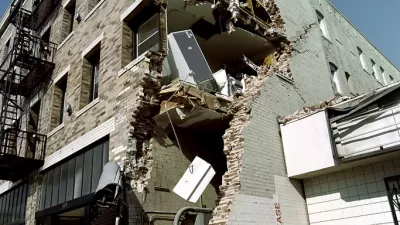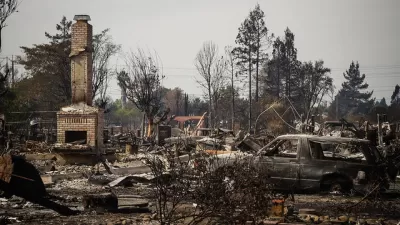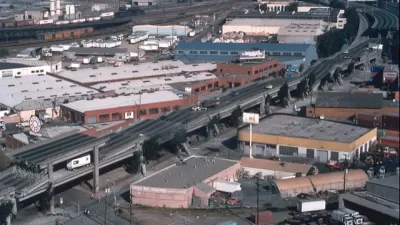1960s and 70s era Dingbat buildings, which are common in many California cities, may be hazardous to more than just your design sensibilities. Their much-loathed parking-oriented designs can make buildings especially vulnerable to earthquakes.
"The threat of earthquakes that could destroy the homes of thousands at any moment has always loomed over San Francisco," writes Aaron Bialick. "In a bid to to reduce that risk, the Board of Supervisors is expected next week to mandate seismic retrofits for nearly 3,000 wood-frame 'soft-story' buildings with five housing units or more that are potentially in danger of collapse."
"But what may be overlooked in the discussion about earthquake safety is how it ties in with city parking policy: Many of the apartment buildings with weak ground-floor structures, or 'soft-story' buildings, were built that way to make room for car parking." And San Francisco's residential parking requirement, which was set in 1960, may be to blame.
Tom Radulovich, executive director of Livable City, "said many buildings in American cities during the 1960s and 70s were built with ground floors completely devoted to parking, leaving little structural support, though they’re less common in SF, than, say, Los Angeles. For these buildings, he used the nickname 'dingbat.'”
“These types of buildings pose a serious threat, because there’s 58,000 San Franciscans that live in these buildings,” said Patrick Otellini, San Francisco’s director of earthquake safety. “If these buildings collapse, because it’s largely a rental [population], these are people that won’t come back to San Francisco.”
FULL STORY: How Car Parking Can Make Earthquakes More Dangerous in San Francisco

Alabama: Trump Terminates Settlements for Black Communities Harmed By Raw Sewage
Trump deemed the landmark civil rights agreement “illegal DEI and environmental justice policy.”

Planetizen Federal Action Tracker
A weekly monitor of how Trump’s orders and actions are impacting planners and planning in America.

The 120 Year Old Tiny Home Villages That Sheltered San Francisco’s Earthquake Refugees
More than a century ago, San Francisco mobilized to house thousands of residents displaced by the 1906 earthquake. Could their strategy offer a model for the present?

Ken Jennings Launches Transit Web Series
The Jeopardy champ wants you to ride public transit.

BLM To Rescind Public Lands Rule
The change will downgrade conservation, once again putting federal land at risk for mining and other extractive uses.

Indy Neighborhood Group Builds Temporary Multi-Use Path
Community members, aided in part by funding from the city, repurposed a vehicle lane to create a protected bike and pedestrian path for the summer season.
Urban Design for Planners 1: Software Tools
This six-course series explores essential urban design concepts using open source software and equips planners with the tools they need to participate fully in the urban design process.
Planning for Universal Design
Learn the tools for implementing Universal Design in planning regulations.
Clanton & Associates, Inc.
Jessamine County Fiscal Court
Institute for Housing and Urban Development Studies (IHS)
City of Grandview
Harvard GSD Executive Education
Toledo-Lucas County Plan Commissions
Salt Lake City
NYU Wagner Graduate School of Public Service





























